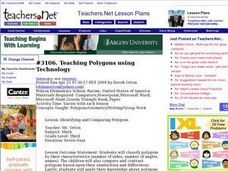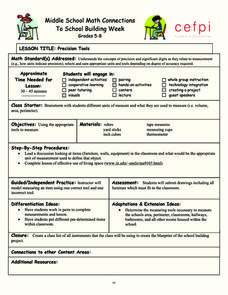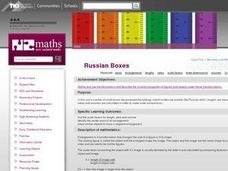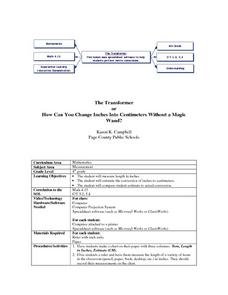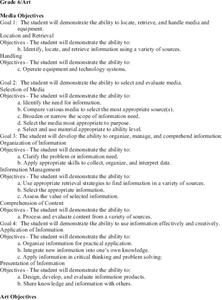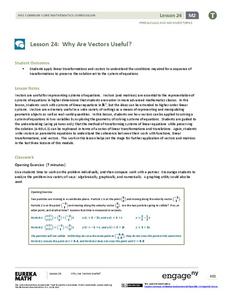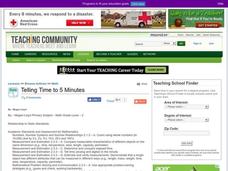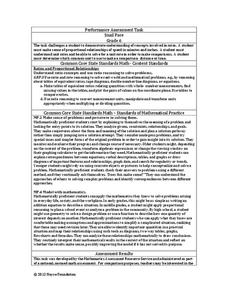Curated OER
Teaching Polygons using Technology
Third graders utilize different types of computer programs, such as Microsoft paint and Microsoft Word to study and create different types of polygons. They use PowerPoint to create a story about a shape and others that it meets during a...
Curated OER
Shapes
Students identify attributes of different geometric shapes. In this geometry lesson plan, students view a PowerPoint presentation on shapes and use attribute blocks to examine the corners and edges of each shape. Students work...
Curated OER
Precision Tools
Students discuss the appropriateness of using a specific tool to measure and define an object. After measuring the area of their classroom and the objects in it with the appropriate tools, they create a floor plan that makes the most...
Curated OER
Russian Boxes
Sixth graders find the scale factors for length, area and volume. They identify the center point of an enlargement and place similar objects to show a negative enlargement. They report the results of an exploration of scale factors in a...
Curated OER
The History of Life
In this extinction worksheet, high schoolers review how species evolve and how species go extinct. Students compare and contrast gradualism and punctuated equilibrium. This worksheet has 6 fill in the blank and 4 short answer questions.
Curated OER
Down on the Farm
Learners are introduced to a map of an Illinois farm. They determine whether the map is of the past, present, or future by looking at features on the map. They also use the map to make a three-dimensional model.
Curated OER
Perimeter and Circumference
Students consider perimeter and circumference. In this instructional activity on perimeter, students will determine relationships between perimeter and circumference using real life examples.
Curated OER
Wow, Saturn Is Much Bigger Than Earth!
Students compare and contrast the sizes of Earth and Saturn. They create scale illustrations of each planet and label them. They share their models with the class.
Curated OER
Pi Mathematics
Students will measure common everyday objects in order to calculate pi. In this measurement lesson plan, students measure the circumference and diameters of objects and fill them into a chart which helps them calculate pi.
Curated OER
Sir Cumference and the Dragon Pi
Geometry adventurers study circumference of a circle as they listen to Sir Circumference and the Dragon Pi, by Cindy Neuschwander. In groups, they use string to measure the diameter and circumference of circular objects and...
Curated OER
Shapes are Everywhere
Second graders gain an understanding of geometric shapes and spatial reasoning. They learn the attributes of solid shapes in everyday activities. Students compare geometric shapes to everday objects, finding things that serve a purpose...
Curated OER
The Transformer
Fourth graders practice measuring different objects in inches. Individually, they estimate the length of the same object in centimeters and then calculate the actual length. They compare and contrast their estimate to the actual length...
Curated OER
Newton’s Laws of Motion
Eighth graders explore the three laws of motion. In this physics lesson, 8th graders observe teacher demonstration and explain what happened in terms of Newton's Laws. They complete worksheet at the end of the lesson.
Curated OER
School Forest Lesson- Looking at Literature
Students compare what they learned though literature to the school forest. In this environment lesson, students visit the forest surrounding their school to listen to literature and identify objects in nature. Students create a...
Curated OER
Air Quality and Transportation
Second graders study about air pollution and the effects it has on our Earth. Students tally cars on a sheet that has been categorized as follows: One person in car, two persons in car, or three or more persons in car. Students go to...
Curated OER
Sculpture
Sixth graders explore the art of sculpture. They examine the sculptural techniques that can be used. Students select sculptural materials, tools, and techniques to create a novel interpretation of an everyday object.
Curated OER
Adjectives
In this ESL adjectives worksheet, students analyze 7 pictures that depict objects of different sizes and shapes. Students match these pictures with the adjectives that describe them.
Mathematics Vision Project
Module 6: Trigonometric Functions
Create trigonometric functions from circles. The first lesson of the module begins by finding coordinates along a circular path created by a Ferris Wheel. As the lessons progress, pupils graph trigonometric functions and relate them to...
EngageNY
Why Are Vectors Useful? 2
Investigate the application of vector transformations applied to linear systems. Individuals use vectors to transform a linear system translating the solution to the origin. They apply their understanding of vectors, matrices,...
AMCO
Clay Face Masks
Let your class explore their sculpting skills with a lesson plan on making clay masks. Each step in the process is fully described alongside a helpful image. Kids of any ages will be able to construct fantastic representations of the...
Curated OER
Rap-Tap-Tap
Fifth graders investigate incline planes and wedges. They identify a variety of incline planes and wedges that are found all around them. Students record their findings using a worksheet.
Curated OER
Telling Time to 5 Minutes
In this second grade lesson plan your class will practice telling time. The goal is to tell time to five minutes using an analog clock. Your young students count by 5 minute intervals and discuss elapsed time.
Noyce Foundation
Snail Pace
Slow and steady wins the race? In the assessment task, scholars calculate the rates at which different snails travel in order to find the fastest snail. Hopefully, your class will move much more quickly in finishing the task!
Curated OER
Butterfly 2: A Butterfly's Home
Young scholars determine which environmental characteristics make up a favorable butterfly habitat.
